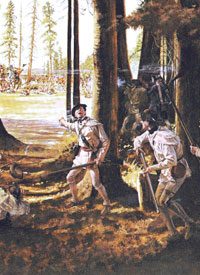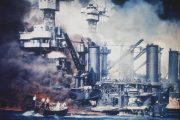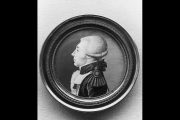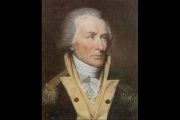
“When the resolution of enslaving America was formed in Great Britain, the British Parliament was advised by an artful man, who was governor of Pennsylvania, to disarm the people; that it was the best and most effectual way to enslave them; but that they should not do it openly, but weaken them, and let them sink gradually.” — George Mason of Virginia, 1788
Our Founding Fathers were absolutely adamant about the right of the people to keep and bear arms. They were students of history and understood that from classical antiquity forward, an armed citizenry was essential to the preservation of freedom. Once disarmed, a people either submitted meekly to tyrants or fought in vain. The American Revolution strongly reinforced the historical perspective of the Founding Fathers: the armed American colonists defeated the mighty British Empire.
While the British had to train their troops quickly in the use of firearms, the American rebels could rely on men who had grown up using firearms as part and parcel of their daily lives. This was especially true on the frontier, where young boys were taught the use of the finest weapon of the era, the Kentucky rifle. By the time they were teenagers, these young men were crack shots whom the family depended upon to hunt game for food and to repel Indian attacks.
The Kentucky rifle — an expertly crafted tool that no frontier family was without — was actually made in Pennsylvania, not Kentucky; the towns of Lancaster and Reading were particularly important centers of production. First called the long rifle because of its long barrel, the firearm later became known as the Kentucky because many famous frontiersmen, including Daniel Boone, used it on their hunting trips into that state.
A Familiar Sight
The craftsmen who manufactured the rifle were the Pennsylvania Dutch — who are not Dutch but German. Dutch comes from Deutsch, meaning German. Historically in America, whenever anyone referred to the Dutchman down the road or the Dutch farmer across the creek, he meant German. The Germans had made the finest rifles in Europe, and the German immigrants to America, comprising about one-third of Pennsylvania’s population, in turn produced the finest rifles in the colonies.
The Kentucky was a flintlock muzzle-loader, with a rifled barrel that ran to three or even four feet in length. The long barrel gave black powder more time to burn, increasing muzzle velocity; it also allowed for finer sighting, resulting in much greater accuracy at greater distances. Most of the rifles came in .40 or .45 caliber, which meant the bullet was heavy enough to smack a target with a wallop but not too heavy to carry long distances. In the hands of an accomplished marksman, the Kentucky could bring down a man or a deer at 100 or more yards and knock a squirrel out of a tree at 200 or more.
Shooting contests were regularly staged all along the colonial frontier — from New England to Georgia. At 70 paces, marksmen would “snuff the candle” or “drive the nail.” In snuffing-the-candle, the lead ball from the rifle would have to pass through the flame of a burning candle, blowing out the flame but striking neither the wick nor the candle. In driving-the-nail, the lead ball would have to strike the head of a nail and drive it further into a post.
The Kentucky had one problem, though: the percussion cap had not yet been invented, and the gun’s powder charge was ignited through the flintlock mechanism. This involved several steps, each with great potential for difficulties. When a rifleman squeezed the trigger, the hammer (or cock) holding a piece of flint fell, striking steel on a small pan of powder outside the breech of the rifle and causing sparks to ignite the powder. The powder then burned through a keyhole, igniting the main powder charge. If everything went right, the expanding gases created by the burning powder propelled the bullet out the barrel.
Dampness and fouling of the powder charge in the pan, however, and hangfire and misfire, were constant problems. As a consequence, the Kentucky fired only about three-quarters or four-fifths of the time. For a flintlock to “flash in the pan” without firing was so common that the expression became an American colloquialism. Reloading usually took up to a minute, although the very best riflemen could accomplish the task in 30 seconds. Nonetheless, 30 seconds was a lifetime — and could mean the end of a rifleman’s life with Indian warriors or British troops or a bear coming at him.
Widow-Makers
Most American frontiersmen became deadeyes and could accomplish shooting feats such as snuffing-the-candle or driving-the-nail as a matter of course. The British marveled at the marksmanship of these riflemen during the Revolutionary War, calling them “widow-makers.” Captain Henry Beaufoy, a British veteran of several wars, remarked,
The Americans, during their war with this country, were in the habit of forming themselves into small bands of ten or twelve, who, accustomed to shooting in hunting parties, went out in a sort of predatory warfare, each carrying his ammunition and provisions and returning when they were exhausted. From the incessant attacks of these bodies, their opponents could never be prepared; as the first knowledge of a patrol in the neighbourhood was generally given by a volley of well-directed fire, that perhaps killed or wounded the greater part.
Beaufoy later noted, “It has been readily confessed … by old soldiers, that when they understood they were opposed by riflemen, they felt a degree of terror never inspired by general action, from the idea that a rifleman always singled out an individual, who was almost certain of being killed or wounded.”
Of all the American riflemen who fought in the Revolutionary War, the most celebrated was Timothy Murphy. It could be said that he was the man who won the war. He was born near Delaware Water Gap in Pennsylvania in 1751. His parents, Thomas and Mary, had only recently arrived in Pennsylvania from County Donegal, Ireland. Within a few years, the family moved to the very cutting edge of the frontier, where land was cheap but so too was life. Indian raids were frequent and could bring death or worse — capture and horrific tortures. Women and girls were not spared. Capture meant gang rape and then mutilation and death, or enslavement. An Irish family such as the Murphys had to adapt quickly or be annihilated. Such was the environment in which Timothy Murphy grew to manhood. By the time he was in his mid-teens, he already had a widespread reputation among both whites and Indians for extraordinary marksmanship and fierceness in battle.
In June 1775, Murphy and his brother John enlisted in Captain John Lowdon’s Company of Northumberland County Riflemen, a component of what was called the Pennsylvania Line. To qualify for service with the company, a rifleman had to fire at and repeatedly hit a seven-inch target at 250 yards, far more than that required for basic marksmanship qualification in any branch of the service today — using modern high-tech rifles. That kind of shooting would immediately get a marksman into a sniper school in the Army or Marines. Dressed in fringed buckskin and carrying knives and tomahawks as well as rifles, Lowdon’s Company of crack riflemen was soon ordered to Boston. The men made the more than 600-mile march in a little more than a month. They could not only shoot but route step.
A Rifleman’s Effect
Murphy fought in the Siege of Boston, then in the battles of Long Island and Westchester. By 1776, he was a sergeant in the 12th Regiment of the Pennsylvania Line and fought at Trenton, Princeton, and New Brunswick. During July 1777, he was transferred to Morgan’s Rifle Corps, led by the legendary Daniel Morgan. A giant of a man with “thick, broad shoulders and arms like tree trunks,” Morgan was born to Welsh immigrant parents in New Jersey (or Pennsylvania). He left home in his mid-teens and finished his growing up on the frontier. He served in the French and Indian War as a teamster, hauling supplies for the British army. For punching a British officer, Morgan suffered a hundred lashes, a punishment that might have killed an ordinary man. His back would be scarred for life. He later served in the war as a ranger in Virginia’s colonial militia, fighting Shawnee in the Ohio Valley. When the Revolution erupted, Morgan joined a rifle company and was immediately elected captain. He served in Benedict Arnold’s expedition to Canada and fought heroically, although he was eventually captured and imprisoned by the British for eight months. Upon his return to the American side in a prisoner exchange, he was promoted to colonel and given command of a special corps of frontier riflemen.
Colonel Morgan and his corps were ordered north to join the American forces opposing General John “Gentleman Johnny” Burgoyne and his force of nearly 10,000 British soldiers that had invaded upstate New York from Canada. It was Burgoyne’s intention to separate New York and the rest of the American colonies from New England.
The American and British armies first clashed on 19 September near Saratoga in the First Battle of Saratoga, or the Battle of Freeman’s Farm. American riflemen, including Timothy Murphy, wreaked havoc, especially on British artillery, picking off artillery officers and gunners by the twos and threes and putting most of the batteries out of the battle. Nonetheless, with volleys of musket fire and bayonet charges, the British eventually drove the Americans from the field of battle, although British losses were twice those suffered by the Americans. It was something of a Pyrrhic victory for the British. The battle could be called a draw. The forces met again on 7 October in the Second Battle of Saratoga, or the Battle of Bemis Heights. The conflict began about two in the afternoon when the British opened fire and attempted to advance on the Americans. Accurate rifle fire by the Americans, however, cut down the British by the dozens. Suddenly, though, a British column, led by Brigadier General Simon Fraser, seemed ready to flank the Americans. Major General Benedict Arnold galloped up to Colonel Morgan and declared that it was up to his corps of riflemen to thwart the British advance. Arnold then pointed to Fraser in the distance and said that the British general was worth an entire regiment.
Morgan called for Sergeant Timothy Murphy, his finest sharpshooter, and said, “That gallant officer is General Fraser. I admire him, but it is necessary that he should die. Do your duty.” Murphy climbed a tree that afforded him a good view of Fraser, mounted on a horse at a distance that was stated, depending on the source, to be either 300 or 500 yards. Even if the shorter distance is correct, it was still a distance that put Fraser, or so he thought, well beyond the range of even the greatly feared American riflemen. While Fraser rallied his troops, Murphy rested his rifle in a notch on a branch, reckoned the wind direction and velocity, the distance, and the number of feet his bullet would drop. Adjusting his aim accordingly, he fired. Fraser dropped to the ground. Mortally wounded, he would die the next day.
Francis Clerke, Burgoyne’s aide-de-camp, galloped onto the field to take command. Murphy fired again and Clerke fell from his saddle, dead. Panic began to spread through the British ranks. Two commanding officers had been killed from an impossible distance. The British line began moving backwards, and men began to break ranks. Seizing the advantage, the Americans attacked. The British troops, already demoralized and retreating, fought for a time, then broke and ran. Burgoyne himself almost fell. American sharpshooters put a bullet into his horse, another one through his coat, and a third through his hat. The battle became a rout. Nearly 500 British soldiers were killed and 700 wounded. Gentleman Johnny and six thousand others later surrendered. Only 90 Americans were killed and 240 wounded.
The great American victory at the Second Battle of Saratoga convinced the French that the American colonists could defeat the British and win independence — if aided by France. This was the moment that many in France had been waiting for, a chance to revenge the loss of their New World empire to Britain in the French and Indian War. If France had lost her vast territory in North America, she would now see to it, by aiding the American rebels, that Britain lost hers. Without the aid of France, it is highly unlikely that we could have won our independence. And without the marksmanship of American rifleman Timothy Murphy at the Second Battle of Saratoga, it is highly unlikely that we would have stopped the British flanking movement and won the battle.
More of Murphy’s Exploits
Murphy would continue fighting until the very end of the war. He spent the winter of 1777-78 with the Continental Army at Valley Forge and was one of those who survived the arctic temperatures and near-starvation of that winter camp. During the spring, he led small parties of riflemen in harassing attacks on British troops withdrawing from Philadelphia. Again his crack shots dropped British soldiers from great distances and spread panic through the ranks. In July, General Washington ordered Murphy and three companies of riflemen to the Mohawk Valley of New York to repel Indian attacks on frontier settlements. The attacks, aided and supported by the British, were particularly bloody, sparing neither women nor children. Murphy was one of those who tracked down and killed Christopher Service, a notorious Tory and British agent who helped arm and supply the Indians. Murphy also participated in the Sullivan Expedition in 1779, a response to the Cherry Valley and Wyoming Valley massacres, which included torture, rape, scalping, beheading, and dismemberment of American men, women, and children. The massacres were perpetrated by four of the six tribes of the Iroquois, who had sided with the British, thinking that Great Britain couldn’t possibly lose a war with the colonists and that they — the Iroquois — could raid American frontier settlements with impunity. For a time the Iroquois were right and delighted in their savage attacks.
Led by Major General John Sullivan, the son of Irish immigrants, a lawyer, a delegate to the Continental Congress, and the veteran of several Revolutionary battles, the expedition sallied forth in June with explicit orders from General Washington to completely eliminate the Iroquois menace forevermore. “The immediate objects are the total destruction and devastation of their settlements,” read Washington’s order, “and the capture of as many prisoners of every age and sex possible. It will be essential to ruin their crops now in the ground and prevent their planting more…. But you will not by any means listen to any overture of peace before the total ruinment of their settlements is effected. Our future security will be in their inability to injure us and in the terror with which the severity of the chastisement they receive will inspire them.”
Just getting his force of some 3,000 soldiers and 250 pack-horse teamsters to the Iroquois country was a logistical challenge for Sullivan, and it wasn’t until August that he really began the systematic destruction of the Indian villages and fields after building Fort Sullivan. The expedition fought several skirmishes but only one major engagement, the Battle of Newtown. The Indians, accustomed to numerical superiority, were awed by the size of Sullivan’s force and fled whenever they had advance warning. Riflemen figured prominently in every contact with the enemy, shooting them at distances that the Iroquois thought magical. By the middle of September, Sullivan had reduced 40 Iroquois villages to ashes and laid waste to their crops. Washington was disappointed that more Iroquois had not been killed, but their once-powerful confederacy had been shredded and they could never again mount anything but raids of limited scope and duration.
During October, Sullivan began marching his troops south to winter quarters in New Jersey. Timothy Murphy was not among them. He remained behind to lead riflemen in the 15th Regiment of the Albany County Militia. His aggressive patrolling earned him a reputation as “the terror of the Tories and Indians.”
In 1780, during a reconnaissance with a Captain Harper along the upper reaches of the Delaware River, Murphy and Harper were ambushed and taken captive by Indians. Knowing they had captured great warriors, the Indians kept them alive, intending to hand them over to the British for a reward. During the night, while the Indians slept, the two bound Americans freed each other and then killed all their captors but one, allowing the sole warrior to live so he could describe to other Indians the might of the American warriors.
Only weeks later, Murphy and some 200 militiamen were surrounded in Middle Fort in the Schoharie Valley of New York. Laying siege were more than 2,000 Indians and British, led by Colonel John Johnson. The situation seemed hopeless for the Americans and the fort’s commanding officer, Major Woolsey, reluctantly decided to surrender to Johnson. The British commander sent an emissary, carrying a white flag, to the fort to accept the surrender. But when the emissary approached the fort, Murphy, acting without authorization, sent a bullet whizzing just over the head of the British representative, who beat a hasty retreat. Johnson sent the emissary out a second time — and Murphy again fired. Again the emissary ran for cover. After the scenario was repeated a third time, Major Woolsey ordered Murphy arrested. Not one of Woolsey’s officers or men would obey the order. Few would have attempted to arrest Murphy in any circumstances, and in this case most sided with Murphy, understanding that surrendering would probably mean an Indian slaughter of all those in the fort, including women and children who had come in from outlying farms seeking protection. One of the women was Murphy’s wife, Peggy, who aided the men by molding bullets and loading rifles. She vowed that she would never surrender and would fashion a spear should the ammunition run out.
Johnson poured fire into the fort but the return fire from Murphy and the other American riflemen was so accurate that Johnson dared not attack. He eventually withdrew and marched north to Niagara, leaving burned farms and slaughtered families in his wake.
By 1781, Murphy was back with a company of the Pennsylvania Line, now 13 regiments strong and under the command of Brigadier General Anthony Wayne. Murphy fought in the Battle of Yorktown and was there to witness the British surrender.
Following the war, Murphy lived on his farm in the Schoharie Valley with Peggy. They eventually had nine children. Several years after Peggy died in 1807, Murphy married again, this time to Mary Robertson. They would have four children. Murphy, widely known for his exploits in the Revolutionary War, was a popular figure in the valley. By the time he died in 1818, he owned several farms and a grist mill.
In 1819, the state legislature of New York voted to erect a monument in his honor. For some reason nothing more was done at the time. In 1929, the state corrected the oversight and finally erected the monument. There to speak at the dedication was New York Governor Franklin Roosevelt. He said:
This country has been made by Timothy Murphys, the men in the ranks. Conditions here called for the qualities of the heart and head that Tim Murphy had in abundance. Our histories should tell us more of the men in the ranks, for it was to them, more than to the generals, that we were indebted for our military victories.
Governor Roosevelt was right, of course. Murphy was emblematic of the common man of the American colonies who outfought trained British troops. But Murphy represented more than that. He was the quintessential American rifleman. He was reared believing that liberty and independence were his birthright and that his firearm was the instrument that guaranteed those God-given freedoms.



